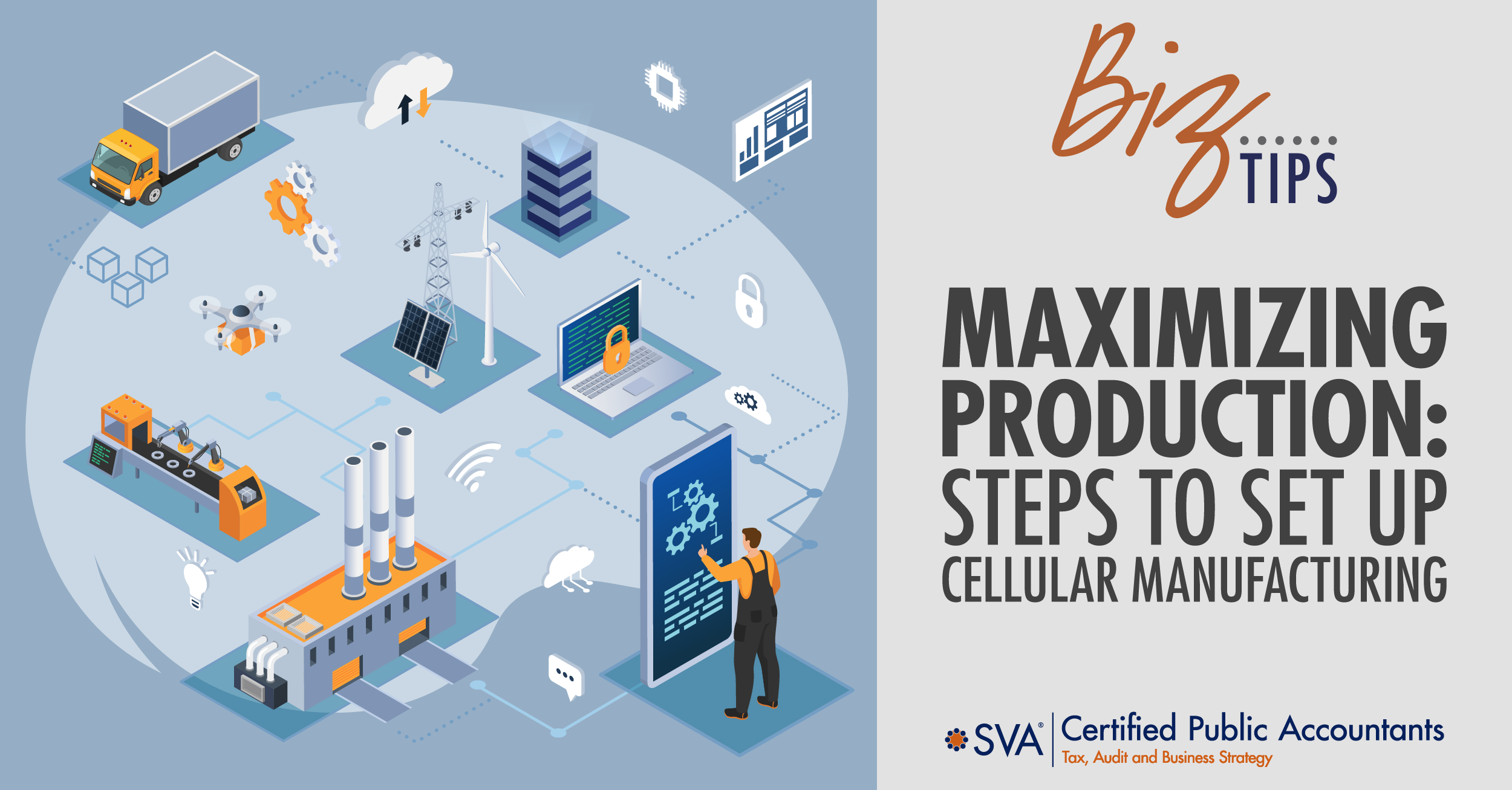| Highlights: |
- Outlines cellular manufacturing as a lean production system that groups workstations into self-contained cells to cut lead times, reduce waste, and improve efficiency.
- Provides a practical, step-by-step setup process including analyzing current workflows, designing cells, implementing standardized work, balancing workloads, and training staff.
- Addresses common challenges like resistance to change and initial costs, and emphasizes continuous improvement and performance monitoring for sustained production gains.
|
Having an optimized and streamlined production process is important to maintain efficiency and stay ahead of the competition.
Cellular manufacturing, a system that organizes workstations into cells, each dedicated to producing a specific product or product family, can be a good option when considering ways to boost production efficiency.
Understanding Cellular Manufacturing
Cellular manufacturing organizes workstations and equipment into small, self-contained units called cells. Each cell is designed to perform a specific set of tasks required to produce a particular product or a family of similar products. The goal of cellular manufacturing is to streamline production by minimizing waste, reducing lead times, and improving overall efficiency.
In this system, each cell operates as a mini-production line, with all necessary resources, including workers, machines, and materials, located close to one another. This proximity allows for smoother material flow, quicker response times, and better communication among team members.
Differences Between Cellular and Traditional Manufacturing
In traditional manufacturing, similar machines are grouped and work is processed in large batches.
Cellular manufacturing focuses on producing smaller batches or even single units in a continuous flow. This shift from batch processing to cellular layouts reduces lead times and minimizes work-in-progress inventory.
Benefits of Implementing Cellular Manufacturing
Implementing a cellular manufacturing layout offers several benefits, including:
- Improved product quality
- Reduced cycle times
- Increased flexibility
By organizing workstations into manufacturing cells, companies can streamline their production processes, reduce waste, and respond more quickly to changes in customer demand.
Steps to Set Up Cellular Manufacturing
1. Analyze Current Processes
Before you can successfully transition to a cellular manufacturing layout, you must thoroughly analyze your current processes.
| Map Out Existing Workflows and Processes |
Start by mapping out your existing workflows to understand how materials and products move through your facility. This will help you identify areas that need improvement. |
| Identify Bottlenecks and Inefficiencies |
Look for bottlenecks, redundancies, and inefficiencies in your current processes that could be eliminated or reduced with a cellular approach. |
| Collect Data on Production Volumes, Cycle Times, and Product Families |
Gather data on production volumes, cycle times, and product families to understand your operational needs and identify opportunities for grouping products into manufacturing cells. |
2. Design Manufacturing Cells
Once you have a clear understanding of your current processes, you can begin designing your manufacturing cells.
| Group Products Into Families Based on Similar Processes |
Start by grouping products with similar processing requirements into families. This will allow you to design manufacturing cells that can handle a range of products with minimal setup changes. |
| Determine the Layout of Each Cell |
Depending on your specific needs, decide on the most effective manufacturing cell layout, whether it's U-shaped, linear, or another configuration. You want to ensure smooth material flow and minimize movement between workstations. |
| Select and Organize Equipment and Tools |
Choose the right equipment and tools for each cell, ensuring they are easily accessible and organized to support efficient operations. |
3. Implement Standardized Workflows
To maximize the efficiency of your manufacturing cells, implement standardized workflows.
| Establish Standard Operating Procedures (SOPs) for Each Cell |
Developing SOPs for each cell will ensure consistency and reduce variability in your production processes. |
| Define Roles and Responsibilities Within Each Cell |
Clearly define the roles and responsibilities of each team member within the cell to ensure smooth operations and accountability. |
| Train Employees on New Processes and Workflows |
Provide training to all employees on the new processes, workflows, and expectations to ensure a smooth transition to cellular manufacturing. |
4. Balancing Workloads
Maintain efficiency and meet customer demand by balancing workloads across your manufacturing cells.
| Calculate Takt Time and Align It With Customer Demand |
Takt time, the rate at which a product needs to be completed to meet customer demand, should be calculated and used to guide production scheduling. |
| Ensure a Balanced Workload Across All Cells to Avoid Bottlenecks |
Distribute work evenly to prevent bottlenecks and ensure a smooth production flow. |
| Implement Cross-Training to Increase Workforce Flexibility |
Cross-train employees to work in multiple cells, allowing you to adjust to fluctuations in demand and maintain balanced workloads. |
5. Continuous Improvement and Monitoring
Finally, to sustain the benefits of cellular manufacturing, establish a culture of continuous improvement and monitoring.
| Set Up Metrics and KPIs to Monitor Performance |
Establish key performance indicators (KPIs) such as cycle time, defect rate, and output quality to monitor the performance of each manufacturing cell. |
| Implement Regular Review Meetings and Feedback Loops |
Hold regular meetings to review performance data, address issues, and make improvements. |
| Encourage a Culture of Continuous Improvement and Employee Involvement |
Foster an environment where employees are encouraged to provide feedback and suggest improvements to processes and workflows. |
Common Challenges and Solutions
As with any significant change, implementing cellular manufacturing can present challenges. Here are some common obstacles and how to overcome them.
Resistance to Change and Employee Buy-In
Employees accustomed to traditional manufacturing methods may have a hard time accepting the change. To overcome resistance, involve employees in the planning process, provide thorough training, and clearly communicate the benefits of cellular manufacturing.
Initial Setup Costs and Resource Allocation
Transitioning to a cellular manufacturing layout may require upfront investment in equipment, training, and restructuring. Careful planning and phased implementation can help manage these costs.
Maintaining Efficiency and Quality Standards Over Time
Continuous monitoring and improvement are critical to maintaining the efficiency and quality gains from cellular manufacturing. Regularly review processes, adjust as needed, and keep your team engaged in the improvement process.
Time to Make a Change?
Making the change to cellular manufacturing can help you maximize production and stay competitive in the market. Increased efficiency, reduced waste, and improved product quality are all reasons to consider an implementation.
Not sure if this is the right move for your facility? Contact our professionals today to learn more about how we can help you determine if cellular manufacturing makes sense for you.
© 2024 SVA Certified Public Accountants

